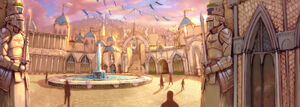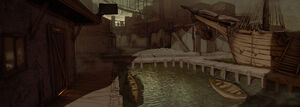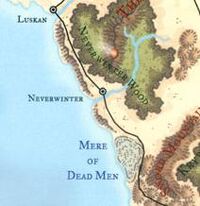Neverwinter, also known as the City of Skilled Hands or the Jewel of the North, was a metropolis sitting on the northwestern Sword Coast of Faerûn.[6] Neverwinter was regarded by Volo as the most cosmopolitan and the most civilized city in all of Faerûn. The city was a member in good standing of the Lords' Alliance.[7]
Etymology
The city of Neverwinter was so named because, even though the town was situated in the cold north of Faerûn, the Neverwinter River that flowed through it was heated by fire elementals living under the nearby Mount Hotenow in the Neverwinter Wood.[5] The heat given off from the river created a permanent warm climate in the immediate area.[4]
The city was originally named "Eiggerstor", which was an Illuskan word. The name "Neverwinter" was the Chondathan translation.[1]
Government
Pre-Spellplague
As of 1370 DR, the city was ruled fairly and justly[8] by Lord Nasher Alagondar, an aging, veteran adventurer and devout worshiper of Tyr.[4] As such, although Neverwinter was prosperous, its master-craftsmen making lamps of multi-coloured glass, precision water clocks and exquisite jewelry, its Tyrran faith promoted justice and fairness, with greed being frowned upon. Lord Nasher ensured that the city was well defended before his death, both physically and magically, against attacks or infiltration from Luskan, Neverwinter's warlike rival. Maps of the city were not allowed to be made as part of an effort to thwart Luskan spies.[7]
Post-Spellplague
In 1462 DR, Dagult Neverember, Open Lord of Waterdeep, seeing an opportunity to add to his financial empire, hired artisans and carpenters to help rebuild the city and Mintarn mercenaries to protect it from monsters; he would eventually create the title of Lord Protector of Neverwinter, held by Neverember himself. However, it was questioned whether Dagult was the rightful ruler, as many factions vied for Neverwinter and the citizens were divided in loyalties.[4] Lord Neverember left the day-to-day running of the city to General Sabine and Mayor Soman Galt.[9]
In 1489 DR, Lord Neverember was exiled from Waterdeep and replaced as Open Lord by Laeral Silverhand.[10] After being ousted of his city and former position, Dagult then focused all of his efforts in his role of Lord Protector of Neverwinter. Due to this commitment and his past accomplishments helping Neverwinter and its citizens, the Neverwintans finally accepted Lord Neverember as their rightful leader.[11]
Structure

Neverwinter in the afternoon

Neverwinter at dusk
Before the eruption of Mount Hotenow, Neverwinter was a picturesque city and boasted such sights as its three spectacular, intricately carved bridges: the Dolphin, the Winged Wyvern and the Sleeping Dragon. Under these, the waters of the Neverwinter River cascaded over small, gentle waterfalls as they coursed into the city's bustling harbour. Neverwinter's magnificent gardens (the phrase "The City of Skilled Hands" referred to Neverwinter's accomplished gardeners) ensured the warm winters were colourful and the summers were rich with fresh fruit.[12]
The city was full of beautiful and ingeniously designed buildings, many of which were famous in their own right, such as The House of Knowledge, and Neverwinter's tall and many-windowed temple of Oghma. In addition, the reputations of such unique taverns as the Moonstone Mask and The Fallen Tower reached far beyond the city's walls and further added to the city's distinction.[12]
After the eruption of Mount Hotenow, the city was almost entirely destroyed. Of the three bridges, only the Winged Wyvern remained functional.[6] Much of the southeastern quadrant of the city collapsed into a yawning pit, known as the Chasm, that continually spawned plaguechanged horrors. Many former edifices and homes became martial garrisons to maintain the monsters at bay.[4]
Although Neverwinter remained in ruins for almost two decades, thanks to Lord Nevermeber's efforts the city was repaired to its former glory in the late years of the 1480s DR. The Chasm was magically sealed and the city was slowly recovering its position as the Jewel of the North.[11]
Trade

Map of Neverwinter on the Sword Coast North.
Around 1370 DR, Neverwinter controlled much of the mining trade from dwarves and gnomes outposts from the nearby Underdark by using hidden ways in various warehouses in the city. Neverwinter also had a large fishing economy, and did good trade in logging from the Neverwinter Wood. The key to Neverwinter's survival, however, was its importance as a center of craftwork, learning, and magical innovation.[12]
History
The first settlement in the Savage Frontier was an elven city known as Illefarn. Illefarn became a bustling nation after the time of the Crown Wars. Illefarn lasted long enough to see the founding of Gauntlgrym and the harnessing of Maegera the Inferno beneath its lands. Eventually, Illefarn was divided into three nations, of which Iliyanbruen was the most prominent.[13]
Iliyanbruen frequently fought with the city of Illusk, which was a legacy of the Netherese. The Netherese city of Xinlenal crashed in Iliyanbruen territories where it would remain hidden for thousands of years.[13] Iliyanbruen was weakened by orc invasions, which paved the way for Eigersstor, the first multi-racial settlement in the area, which would later be called Neverwinter.[14]
Neverwinter became a center of civilization, peace and culture and was widely viewed as a marvel by visitors. This trend lasted, seemingly unbroken since its founding (with the exception of a couple of orc hordes, the violent debacle following the Orcgates Affair and the assassination attempts against the sage Rahalaglingalade),[15] until 1372 DR when a disease known as the Wailing Death laid low most of the city's inhabitants.[16]
Although Lord Nasher died during the Spellplague, he gave rise to a royal line that ruled until Mount Hotenow erupted, destroying the majority of the city. Thayans and their Ashmadai allies attacked the city in the wake of the eruption, hoping to cause enough deaths to fuel a Dread Ring but their plans were foiled with the help of adventurers and agents of Netheril. Due to the help given by the Netherese, the shadovar attempted a power grab in the city but were driven out when Herzgo Alegni was defeated in combat by Artemis Entreri and Dahlia Sin'felle, which inspired a revolt against Herzgo's netherese 'Shadow Guard'.[17]
In 1462 DR, Lord Neverember, claiming himself to be a descendant of Neverwinter's former rulers and thus the rightful "Lord Protector" of Neverwinter, started the New Neverwinter movement. Lord Neverember invested a great deal of his own personal fortune to rebuild the city infrastructure, buy the interest of merchants to send their caravans again to Neverwinter, and even ensuring Neverwintan refugees had enough food and gold in hand.[9] By the late years of the 1480s DR, Neverember's efforts to rebuild the city proved successful, and Neverwinter had slowly being restored as a center of civilization in the Sword Coast North.[11]
Neverwinter in games
- Neverwinter Nights series of games.
Many years before the 14th century DR, the forces of Neverwinter were involved in a battle with the King of Shadows. None of the men sent into combat survived the battle, although the garrison at Fort Locke survived a demonic onslaught.[18]
In 1372 DR the city succumbed to the Wailing Death, a disease that resisted magical healing and killed much of the population of the city. The cure was eventually found but the casualties by that time were catastrophic. It was soon discovered that the Wailing Death was merely the precursor of war between Neverwinter and its enemy, the city of Luskan. Although it was the Sarrukh Queen Morag who sponsored the war, rather than the Host Tower of the Arcane, the fighting (which ended in a stalemate, thanks to a plucky adventurer known only as the Hero of Neverwinter) soured the relationship between the two cities even more.[19]
Despite this, a shaky relationship between Neverwinter and Luskan was reestablished until an upstart Host Tower mage named Black Garius attempted to raise an undead army to conquer Neverwinter, ostensibly in the name of the King of Shadows. Again, an adventurer put an end to the plans of Black Garius and defeated the King of Shadows once and for all.[18]
Unfortunately the conflict, which came to be known as the Shadow War, left the economy of the Sword Coast North in tatters, and its security was in doubt due to the deaths of so many Greycloaks during the fighting. This made it a great opportunity for an enterprising Samarachan mercantile house led by a woman named Sa'Sani. Under her leadership, and with the assistance of a group of adventurers, the Neverwinter region's economy was brought back to health by the end of the Year of Lightning Storms.[20]
Post-Spellplague
- Neverwinter game.
- See also: Neverwinter (game)
Neverwinter and other cities north of Waterdeep fared poorly in the years following the Spellplague, and by the 1479 DR both it and Luskan were in utter ruins. Minor earthquakes had troubled Neverwinter for months, eventually resulting in an eruption from Mount Hotenow with mounds of lava and superheated ash falling down on the city. Half of the city's population died in a heartbeat, with many great buildings razed. A great rift known as the Chasm ripped apart the Earth of the city and strange zombies of ash haunted the ruins. Yet after the destruction, many who had fled upon the minor earthquakes returned, bringing looters and thieves with them. The people began to rebuild and eventually, arriving with a host of mercenaries from Mintarn, Dagult Neverember arrived and styled himself the Lord Protector of Neverwinter.[21]
Military
As of 1372 DR, Neverwinter had a standing army of 400 archers and spearmen, that doubled as a city guard and patrolled the High Road from Port Llast to Leilon. During peacetime, 60 of these soldiers were assigned to the city watch, 60 were on leave and 60 were sent to retraining. If the city's walls were threatened by orcs or Luskan attackers, the defenders could catapult explosive missiles down on the attackers. Both missiles and the specially designed catapults were devised by the best 'skilled hands' of the city's namesake. In desperate situations, Lord Nasher could call upon the wizards of the Order of the Many-Starred Cloak.[7]
As of 1479 DR, the army of Neverwinter was composed mostly by the Mintarn mercenaries hired by Lord Neverember and a few independent militia forces assembled by the citizens or rebel groups such as the Sons of Alagondar. Lord Neverember also hired adventuring bands to eliminate threats to the city that the Mintarn mercenaries could not handle.[4]
With the city rebuilding in the late years of the 1480s DR, many of the Sons of Alagondar volunteered themselves to serve as the city guard, making Lord Neverember to depend less of the services of the Mintarn mercenaries. Lord Neverember still hired a few adventurers and mercenaries to help to protect Neverwinter and train the local troops rather than to accept the help of the armies of the Masked Lords of Waterdeep, who he felt had betrayed him.[11]
Trivia
The city of Neverwinter serves as the origin of the phrase "By the clocks of Neverwinter", used when one is solemnly swearing, a reference to the precision of its timepieces.[7]
Gallery
Appendix
Appearances
Video games
- Neverwinter Nights (AOL)
- Neverwinter Nights
- Neverwinter Nights 2
- Dungeons and Dragons: Neverwinter
Novels
References
- ↑ 1.0 1.1 Reynolds, Forbeck, Jacobs, Boyd (March 2003). Races of Faerûn. (Wizards of the Coast), p. 93. ISBN 0-7869-2875-1.
- ↑ R.A. Salvatore (October 2011). Neverwinter. (Wizards of the Coast), p. 146. ISBN 0-7869-5842-1.
- ↑ Matt Sernett, Erik Scott de Bie, Ari Marmell (August 2011). Neverwinter Campaign Setting. Edited by Tanis O'Connor. (Wizards of the Coast), p. 86. ISBN 0-7869-5814-6.
- ↑ 4.0 4.1 4.2 4.3 4.4 4.5 4.6 Matt Sernett, Erik Scott de Bie, Ari Marmell (August 2011). Neverwinter Campaign Setting. Edited by Tanis O'Connor. (Wizards of the Coast), p. 138. ISBN 0-7869-5814-6.
- ↑ 5.0 5.1 5.2 Ed Greenwood, Sean K. Reynolds, Skip Williams, Rob Heinsoo (June 2001). Forgotten Realms Campaign Setting 3rd edition. (Wizards of the Coast), p. 176. ISBN 0-7869-1836-5.
- ↑ 6.0 6.1 Matt Sernett, Erik Scott de Bie, Ari Marmell (August 2011). Neverwinter Campaign Setting. Edited by Tanis O'Connor. (Wizards of the Coast), p. 8. ISBN 0-7869-5814-6.
- ↑ 7.0 7.1 7.2 7.3 Ed Greenwood (1993). Volo's Guide to the North. (TSR, Inc), pp. 130–131. ISBN 1-5607-6678-6.
- ↑ slade, et al. (April 1996). The North: Guide to the Savage Frontier. Edited by James Butler. (TSR, Inc.), p. Cannot cite pages from this boxed set. See {{Cite book/The North: Guide to the Savage Frontier}} for a list of citations that may be used.. ISBN 0-7869-0391-0.
- ↑ 9.0 9.1 Matt Sernett, Erik Scott de Bie, Ari Marmell (August 2011). Neverwinter Campaign Setting. Edited by Tanis O'Connor. (Wizards of the Coast), p. 88. ISBN 0-7869-5814-6. Cite error: Invalid
<ref>tag; name "NCS-p88" defined multiple times with different content - ↑ Steve Winter, Alexander Winter, Wolfgang Baur (November 2014). The Rise of Tiamat. Edited by Scott Fitzgerald Gray. (Wizards of the Coast), pp. 14–15. ISBN 978-0786965656.
- ↑ 11.0 11.1 11.2 11.3 Steve Kenson, et al. (November 2015). Sword Coast Adventurer's Guide. Edited by Kim Mohan. (Wizards of the Coast), pp. 51–52. ISBN 978-0-7869-6580-9.
- ↑ 12.0 12.1 12.2 Ed Greenwood (1993). Volo's Guide to the North. (TSR, Inc), pp. 132–134. ISBN 1-5607-6678-6.
- ↑ 13.0 13.1 Matt Sernett, Erik Scott de Bie, Ari Marmell (August 2011). Neverwinter Campaign Setting. Edited by Tanis O'Connor. (Wizards of the Coast), p. 12. ISBN 0-7869-5814-6.
- ↑ Brian R. James, Ed Greenwood (September 2007). The Grand History of the Realms. Edited by Kim Mohan, Penny Williams. (Wizards of the Coast), p. 61. ISBN 978-0-7869-4731-7.
- ↑ Matt Sernett, Erik Scott de Bie, Ari Marmell (August 2011). Neverwinter Campaign Setting. Edited by Tanis O'Connor. (Wizards of the Coast), p. 13. ISBN 0-7869-5814-6.
- ↑ Brian R. James, Ed Greenwood (September 2007). The Grand History of the Realms. Edited by Kim Mohan, Penny Williams. (Wizards of the Coast), p. 153. ISBN 978-0-7869-4731-7.
- ↑ R.A. Salvatore (October 2011). Neverwinter. (Wizards of the Coast), p. ??. ISBN 0-7869-5842-1.
- ↑ 18.0 18.1 Obsidian Entertainment (October 2006). Designed by Ferret Baudoin, J.E. Sawyer. Neverwinter Nights 2. Atari.
- ↑ BioWare (June 2002). Designed by Brent Knowles, James Ohlen. Neverwinter Nights. Atari.
- ↑ Obsidian Entertainment (November 2008). Designed by Tony Evans. Neverwinter Nights 2: Storm of Zehir. Atari.
- ↑ Template:Cite game/Neverwinter Nights (MMO)
Further reading
- Ed Greenwood, Sean K. Reynolds, Skip Williams, Rob Heinsoo (June 2001). Forgotten Realms Campaign Setting 3rd edition. (Wizards of the Coast), p. 176. ISBN 0-7869-1836-5.
- slade, et al. (April 1996). The North: Guide to the Savage Frontier. Edited by James Butler. (TSR, Inc.). ISBN 0-7869-0391-0.
- Ed Greenwood (1993). Volo's Guide to the North. (TSR, Inc). ISBN 1-5607-6678-6.
- Matt Sernett, Erik Scott de Bie, Ari Marmell (August 2011). Neverwinter Campaign Setting. Edited by Tanis O'Connor. (Wizards of the Coast). ISBN 0-7869-5814-6.

